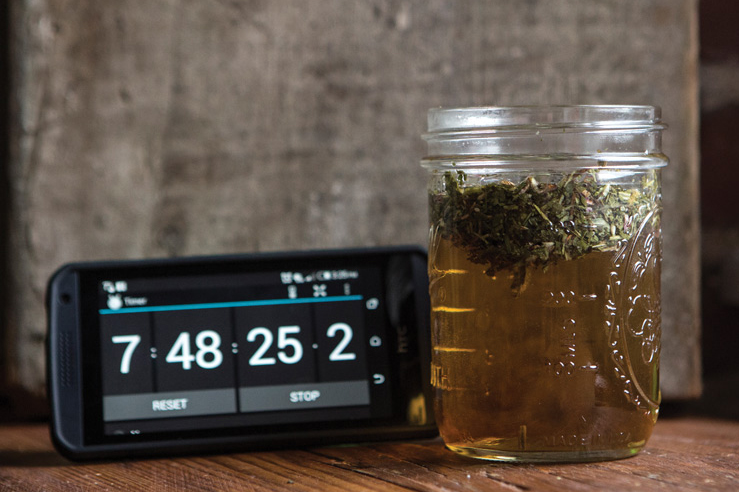[W]hen I got seriously into tea around 2000, it was a real aha moment for me. I noticed all sorts of changes in my health and my quality of life. I centered my life around tea, eventually moving to Taiwan to study the leaf full time. And I never thought I’d have another aha moment quite like that again.
I was wrong. Last year, I decided to expand my tea education deeper into the realm of herbal infusions. After quite a bit of research, I landed in a thirteen-week apprenticeship with herbalist and author Susun Weed. During the apprenticeship, I replaced my tea habit with a quart of “nourishing herbal infusion” a day. I was shocked at its potency compared to tea and to regular steeped herbs, and I think you will be, too. From the science to the daily know-how, here’s what surprised then nourished me in the world of herbal infusions.
Most of the drinks we brew (coffee, tea, herbs such as chamomile and mint) are high in volatile compounds. As the name suggests, these substances are usually the first things to be extracted when hot water hits dried plant material. They give drinks much of the flavor and aroma that make them so appealing.
The average herbal tea is not nearly so nourishing as you think it is.
However, there are many important nutrients hidden within plant materials, such as proteins and minerals, which are not extracted in significant levels during the typically short brew times we use. This is a topic researchers have addressed in scientific publications such as Food Research International and Journal of Food Engineering. Their conclusions? The average “herbal tea” is not nearly so nourishing as you think it is.
There are two reasons typical herbal infusions can’t live up to the hype. First, the amount of time they’re brewed isn’t long enough to extract their minerals and proteins. Second, there’s just not that much plant material used to make a cup of herbal tea. Imagine changing your diet by adding in a small bite of cooked spinach every day. Beneficial? Not really. But if you’re considering minerals and proteins, it could be more rewarding than an added cup of herbal infusion brewed from a teabag or a tablespoon of herbs. But there are methods out there for getting more out of herbs.
The most common of these is decoction, boiling plant materials to release their goodies. Some (such as herbalists in China) believe that a vile tasting brew is acceptable (or even beneficial). Others are of the spoonful-of-sugar school, preferring herbal decoctions boiled with milk and sugar (i.e., chai). These approaches both have their drawbacks. The latter results in the binding of proteins in milk to certain antioxidants and an added sugar intake (thus offsetting some of the health benefits) and the former results in many people refusing to drink the stuff (thus removing all the health benefits).
Weed taught me another way of getting the good stuff. She advises using far more than a teabag-sized quantity of herb and brewing far longer than the usual five minutes used for an herbal tea. In fact, she recommends using one ounce of herb per quart of boiling water, which (depending on the herb) is a whopping quarter cup to three-quarters of a cup of dried herb per cup of water, and steeping the infusion for six to eight hours.
As common sense would indicate, and numerous studies have shown, a longer extraction time means more nutrients. The resulting “nourishing herbal infusions” are deliciously rich in flavor and have a lot more to offer in terms of minerals, proteins, vitamins, and antioxidants.
Weed recommends drinking a rotation of these five mineral- and protein-rich herbs: stinging nettle, whole linden leaf, green oatstraw, red clover, and comfrey leaf. It’s important to note that not all herbs should be steeped this way, so consult an herbalist on other plants. Weed emphasizes that which days you drink which herbs is of no more consequence than which day you eat rice and which day you eat bread. “Infusions are foods, not drugs,” she says firmly.
Justine Smythe, Weed’s daughter and a local business owner, told me nourishing herbal infusions can be a hard sell. “Customers couldn’t readily see the difference between nourishing herbal infusions and regular infusions,” she said, adding that justifying the price difference was a challenge.
So while the science is there, the understanding might not be. But for those used to quick and easy infusions, it’s powerful to look at herbs in this light. While we know Camellia sinensis carries a lot of benefits with regular consumption, tisanes may ask more of each brew to be considered revitalizing. While baristas might not be brewing this way tomorrow, knowing more about the power of long steeps helps us understand more about what those health-conscious consumers might really want when they request more energizing matcha, soothing mint, and nourishing nettle.
—Lindsey Goodwin is a tea writer and consultant.
















